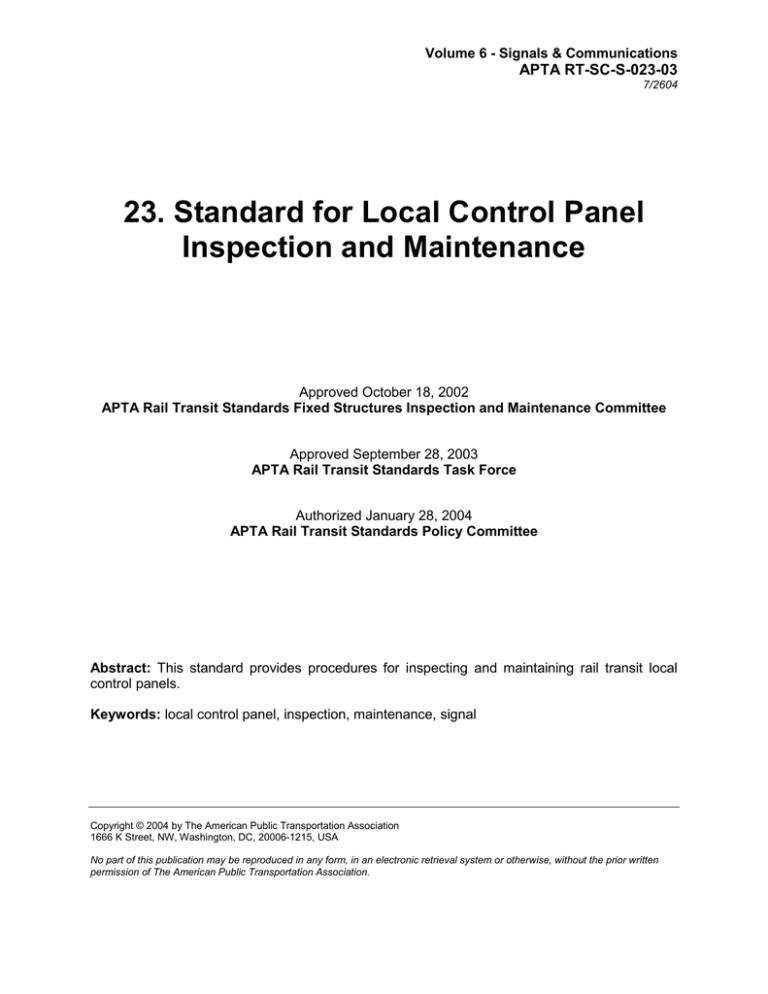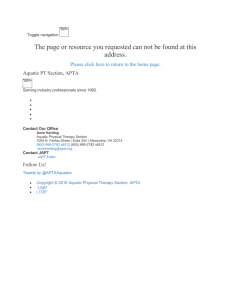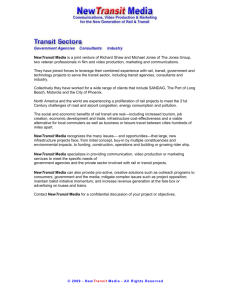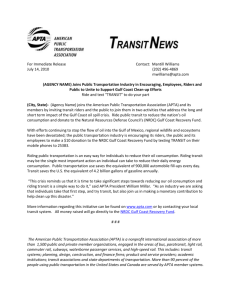
Volume 6 - Signals & Communications
APTA RT-SC-S-023-03
7/2604
23. Standard for Local Control Panel
Inspection and Maintenance
Approved October 18, 2002
APTA Rail Transit Standards Fixed Structures Inspection and Maintenance Committee
Approved September 28, 2003
APTA Rail Transit Standards Task Force
Authorized January 28, 2004
APTA Rail Transit Standards Policy Committee
Abstract: This standard provides procedures for inspecting and maintaining rail transit local
control panels.
Keywords: local control panel, inspection, maintenance, signal
Copyright © 2004 by The American Public Transportation Association
1666 K Street, NW, Washington, DC, 20006-1215, USA
No part of this publication may be reproduced in any form, in an electronic retrieval system or otherwise, without the prior written
permission of The American Public Transportation Association.
Volume 6 - Signals & Communications
APTA RT-SC-S-023-03
7/2604
Introduction
(This introduction is not a part of APTA RT-SC-S-023-03, Standard for Local Control Panel Inspection and
Maintenance.)
APTA rail transit safety standards represent an industry consensus on safety practices for rail transit
systems to help achieve a high level of safety for passengers, employees, and the general public. This
document was created by and for those parties concerned with its provisions; namely, rail transit systems
(operating agencies), manufacturers, consultants, engineers, and general interest groups. This standard
provides procedures for inspecting and maintaining rail transit local control panels.
APTA recommends this standard for:
–
Individuals or organizations that inspect, maintain, and/or operate rail transit systems
–
Individuals or organizations that contract with others for the inspection, maintenance, and/or
operation of rail transit systems
–
Individuals or organizations that influence how rail transit systems are inspected, maintained,
and/or operated (including but not limited to consultants, designers, and contractors)
This standard intends to meet the following objectives:
–
To ensure special life/safety equipment is operational and reliable
–
To help rail transit systems incorporate safety considerations during the inspection and
maintenance process
–
To identify inspection criteria and maintenance standards that provide a high level of passenger
and personnel safety
The application of any standards, practices, or guidelines contained herein is voluntary. In some cases,
federal and/or state regulations govern portions of how a rail transit system operates. In such cases, the
government regulations override any conflicting practices this document requires or recommends.
Copyright © 2004 APTA. All rights reserved.
23.ii
Volume 6 - Signals & Communications
APTA RT-SC-S-023-03
7/2604
Participants
APTA greatly appreciates the contributions of the following members of the Signals and Communications
Subcommittee who provided the primary effort in drafting the Standard for Local Control Panel
Inspection and Maintenance:
Carlton “Don” Allen, P.E.
Sal Arceo
Gabrielle Bayme
Paul Camera
Lenny De Meyer
Michael Esford
Patrick Lavin
Ruben Madrigal
Thomas Peacock
Stephen Roberts
Carey Vaughn
The following members of the Rail Transit Standards Fixed Structures Inspection and Maintenance
Committee contributed to the review and approval process of the Standard for Local Control Panel
Inspection and Maintenance:
James Dwyer, Chair
Frank Cihak, Vice Chair
Anthony Adams
Carlton “Don” Allen, P.E.
Sal Arceo
Roger Avery
Peter Bertozzi
Steven Bezner, P.E.
Raymond Borge
Michael Brown
John Bumanis
Clay Bunting
R. Sean Burgess
Paul Camera
David Cappa, P.E.
Gricelda Cespedes
Robert Chappell
Frank Cihak
Catherine Cronin
Lenny De Meyer
Tom Devenny
David Dunderdale
James Dunn
James Dwyer
William Early, P.E.
Percy Erves
Michael Esford
Richard Falcon
Ray Favetti
Peter Fedun, P.E.
Steve Feil
Robert Fiore
John Gaito
Ricky Green
Mohammad Irshad
Patrick Lavin
Harry Lupia
Frank Machara
Ruben Madrigal
Michael Monastero
Bill Petit
David Rankin
Pingali Rao, P.E.
Richard Raschke
James Redding
Stephen Roberts
Charles Slavis, P.E.
Frederick Smith, P.E.
Richard Spatz
Charles Stanford
F. Brian Steets
Paul Swanson, P.E.
Steven Thompson
Fred Tijan
Gary Touryan
Carey Vaughn
James Wang, P.E.
APTA Rail Transit Standards Fixed Structures Inspection and Maintenance Committee project
consultants:
Peter Gentle, P.E., STV Incorporated
Carol Rose, STV Incorporated
APTA Rail Transit Standards project team:
Gabrielle Bayme, Standards Development Program Specialist and Project Editor
Saahir Brewington, Administrative Assistant and Project Editor
Antoinette Hankins, Program Assistant
Thomas Peacock, Director-Operations & Technical Services
David Phelps, Senior Project Manager - Rail Programs
Copyright © 2004 APTA. All rights reserved.
23.iii
Volume 6 - Signals & Communications
APTA RT-SC-S-023-03
7/2604
Contents
1. Overview ..............................................................................................................................................23.1
1.1 Scope..............................................................................................................................................23.1
1.2 Purpose...........................................................................................................................................23.1
1.3 Alternate practices .........................................................................................................................23.1
2. Definitions and acronyms.....................................................................................................................23.2
2.1 Definitions......................................................................................................................................23.2
2.2 Acronyms.......................................................................................................................................23.3
3. Inspection and maintenance requirements ...........................................................................................23.3
3.1 Inspection and maintenance frequency ..........................................................................................23.3
3.2 Training..........................................................................................................................................23.3
3.3 Materials ........................................................................................................................................23.4
3.4 Tools ..............................................................................................................................................23.4
3.5 Personal protective equipment .......................................................................................................23.4
3.6 Safety .............................................................................................................................................23.4
3.7 Inspection and maintenance procedures ........................................................................................23.5
3.8 Correction of deficiencies ..............................................................................................................23.7
3.9 Documentation...............................................................................................................................23.7
Annex A (informative) Bibliography.......................................................................................................23.8
Copyright © 2004 APTA. All rights reserved.
23.iv
Volume 6 - Signals & Communications
APTA RT-SC-S-023-03
7/2604
Standard for Local Control Panel Inspection and
Maintenance
1. Overview
1.1 Scope
This document establishes standard requirements for inspecting and maintaining rail transit local
control panels.
1.2 Purpose
The purpose of this standard is to verify that local control panels are operating safely and as
designed through periodic inspection and maintenance, thereby increasing reliability and
reducing the risk of hazards and failures.
1.3 Alternate practices
Individual rail transit systems may modify the practices in this standard to accommodate their
specific equipment and mode of operation. APTA recognizes that some rail transit systems may
have unique operating environments that make strict compliance with every provision of this
standard impossible. As a result, certain rail transit systems may need to implement the standards
and practices herein in ways that are more or less restrictive than this document prescribes. A rail
transit system (RTS) may develop alternates to the APTA standards so long as the alternates are
based on a safe operating history and are described and documented in the system’s safety
program plan (or another document that is referenced in the system safety program plan).
Documentation of alternate practices shall:
a) Identify the specific APTA rail transit safety standard requirements that cannot be met
b) State why each of these requirements cannot be met
c) Describe the alternate methods used
d) Describe and substantiate how the alternate methods do not compromise safety and
provide a level of safety equivalent to the practices in the APTA safety standard
(operating histories or hazard analysis findings may be used to substantiate this claim).
Copyright © 2004 APTA. All rights reserved.
23.1
Volume 6 - Signals & Communications
APTA RT-SC-S-023-03
7/2604
2. Definitions and acronyms
For the purposes of this standard, the following definitions and acronyms apply:
2.1 Definitions
2.1.1 eyelet: A closed loop electrical fastener that provides a terminating point for wiring. Also
referred to as ring terminal.
2.1.2 hazard: Any real or potential condition that can cause injury, death, or damage or loss of
equipment or property.
2.1.3 insulating block: An inert, dielectric part that prohibits the passage of electrical current
between two electrically active metal components.
2.1.4 local control panel: A panel displaying a line diagram of the trackage in and near a
particular interlocking or group of interlockings, and equipped with various pushbuttons, electric
switches, indicator lights, and audible alarms to allow control and monitoring of that section of
trackage. Syn: interlocking control panel.
2.1.5 operations control center (OCC): That facility from which train control, train
dispatching, and/or train supervision takes place for the entire RTS or for specific segments of a
system if there is more than one control center. Syn: rail control center, rail operations center,
rail service control center, train command center.
2.1.6 original equipment manufacturer (OEM): The enterprise that initially designs and
builds a piece of equipment.
2.1.7 personal protective equipment (PPE): All clothing and other work accessories designed
to create a barrier against workplace hazards. Examples include safety goggles, blast shields,
hard hats, hearing protectors, gloves, respirators, aprons, and work boots.
2.1.8 rail transit system (RTS): The organization or portion of an organization that operates
rail transit service and related activities. Syn: operating agency, operating authority, transit
agency, transit authority, transit system.
2.1.9 terminal block: A molded non-conductive material containing one or more electrical
wiring terminals. See also: terminal board.
2.1.10 terminal board: A small panel made of non-conductive materials containing one or
more electrical wiring terminals. See also: terminal block.
2.1.11 terminal post: A terminal designed to electrically connect two or more wires. Syn:
binding post.
Copyright © 2004 APTA. All rights reserved.
23.2
Volume 6 - Signals & Communications
APTA RT-SC-S-023-03
7/2604
2.2 Acronyms
ac
dc
LED
OCC
OEM
PPE
RTS
alternating current
direct current
light emitting diode
operations control center
original equipment manufacturer
personal protective equipment
rail transit system
3. Inspection and maintenance requirements
3.1 Inspection and maintenance frequency
The inspection and maintenance procedures in this standard shall be performed when local
control panels are placed in service, when they are modified, repaired, or disarranged, or as
otherwise deemed necessary by the RTS. The RTS shall schedule inspection and maintenance to
avoid potential impact on rail operations.
The RTS shall determine the need for additional inspection and maintenance frequencies for
local control panels. A review of the following factors may be useful in making this assessment:
–
OEM-recommended intervals
–
Industry experience
–
Operating environment/conditions
–
Historical data
–
Reliability-centered maintenance program development
–
Failure analysis
–
RTS testing and experience
–
Regulatory requirements
The frequency of tasks shall comply with applicable federal, state, and local regulations.
3.2 Training
The RTS and/or their maintenance contractors shall develop and execute training programs that
provide employees with the knowledge and skills necessary to safely and effectively perform the
tasks outlined in this standard.
Copyright © 2004 APTA. All rights reserved.
23.3
Volume 6 - Signals & Communications
APTA RT-SC-S-023-03
7/2604
3.3 Materials
The following materials are required for inspecting and maintaining local control panels:
–
Dust clothes and/or other RTS-approved dusting utensils
–
RTS-approved contact cleaner
–
Lint-free cloths
–
Appropriate bulbs/LED
–
Additional materials as required by the OEM and/or RTS
3.4 Tools
The following tools are required for inspecting and maintaining local control panels:
–
Allen keys
–
Bulb extractor
–
Multi-meter*
–
Terminal nut wrench
–
RTS-approved portable radio
–
Standard tools carried by maintenance personnel
–
Additional tools as required by the OEM and/or RTS
* Calibrate in accordance with OEM and/or RTS requirements.
3.5 Personal protective equipment
Personal protective equipment, as required by the RTS, shall be worn at all times during
inspection and maintenance.
3.6 Safety
RTS established safety rules, procedures, and practices shall be followed at all times during
inspection and maintenance procedures.
Copyright © 2004 APTA. All rights reserved.
23.4
Volume 6 - Signals & Communications
APTA RT-SC-S-023-03
7/2604
3.7 Inspection and maintenance procedures
Local control panel inspection and maintenance procedures may be modified for each rail transit
system’s requirements (see Section 1.3) but shall contain the steps listed in Sections 3.7.1-3.7.14
as a minimum.
3.7.1
Notify the operations control center (OCC) and/or other authorities of the inspection and
maintenance activities to be performed.
3.7.2
Inspect local control panel equipment for condition of wire tags, defective insulation,
heat, and loose, corroded, rusted, damaged, or missing connectors and terminals.
3.7.3
Inspect local control panel equipment for rust, corrosion, damage, cracks, breaks,
defective latches, locks, hinges, covers, weather seals, gaskets, loose, deteriorated, or
damaged conduit connections, and missing or loose components and hardware. Holes and
unused entrances not used for ventilation shall be sealed.
3.7.4
Clean the internal and external parts of local control panel. Replace worn or defective
parts.
3.7.5
Ensure all contacts, if so equipped, are properly adjusted and in good condition.
3.7.6
Ensure all serial/plug coupler connections, if so equipped, are secure.
3.7.7
Ensure required component seals are properly secured in compliance with RTS
requirements.
3.7.8
Ensure manipulation charts and/or other test procedure documents established by the
RTS are readily available.
3.7.9
Ensure local control panels equipped with transfer control key switches have the
appropriate key available for immediate use. Ensure the key is secured as prescribed by
the RTS.
3.7.10 Take control of the local control panel.
3.7.11 Ensure power supplies and train control equipment associated with local control panel are
indicating/functioning as intended. The following indications/functions,
applicable, shall be checked and/or tested for proper operation:
where
a) track occupancy
b) signal aspect
c) train routing
d) alternating current (ac) power off
Copyright © 2004 APTA. All rights reserved.
23.5
Volume 6 - Signals & Communications
APTA RT-SC-S-023-03
7/2604
e) direct current (dc) power off
f) ac blown fuse
g) dc blown fuse
h) auxiliary switch operation
i) transfer of control
j) switch position
k) switch transition
l) traffic controls
m) code system status
n) microprocessor status
o) wheel detector status
p) compressed air supply
q) snow melting equipment status
r) ac ground detection
s) dc ground detection
t) smoke/fire intrusion alarms
u) bridge position
v) bridge operation
w) route request
x) route request cancel
y) public address equipment
z) signal maintainer horn / buzzer
aa) sound power phones/communication devices
bb) volt meters
cc) amp meters
Copyright © 2004 APTA. All rights reserved.
23.6
Volume 6 - Signals & Communications
APTA RT-SC-S-023-03
7/2604
dd) diagnostic equipment
ee) additional train control equipment controlled or monitored by the local control panel
3.7.12 Ensure all covers and locks are in place and secured.
3.7.13 Perform additional tests as required by the OEM and/or RTS.
3.7.14 Notify the OCC and/or other authorities when inspection and maintenance activities are
complete.
3.8 Correction of deficiencies
Deficiencies identified during local control panel inspection and maintenance shall be corrected
and documented in accordance with OEM and/or RTS requirements.
3.9 Documentation
Inspection and maintenance activities shall be documented, reviewed, and filed in accordance
with RTS procedures.
Copyright © 2004 APTA. All rights reserved.
23.7
Volume 6 - Signals & Communications
APTA RT-SC-S-023-03
7/2604
Annex A
(informative)
Bibliography
[B1]
New York City Transit, Division of Signals, Interlocking and Test Report form, 1992.
[B2]
New York City Transit, Division of Signals, Standard Procedures Manual, 7.66.110 through
7.66.437, 1992.
[B3]
Original equipment manufacturer (OEM) specifications for local control panel inspection and
maintenance.
[B4]
Rail transit system (RTS) procedures for local control panel inspection and maintenance.
Copyright © 2004 APTA. All rights reserved.
23.8



